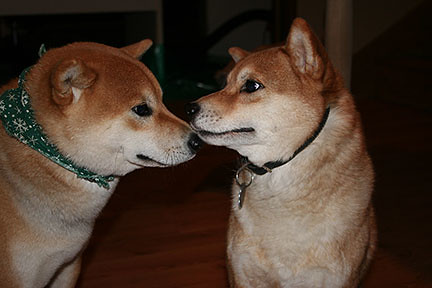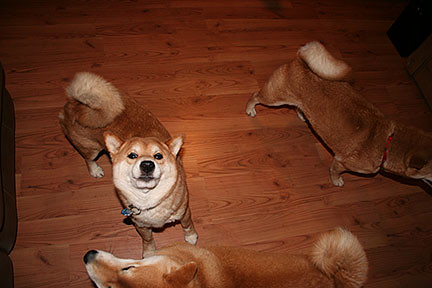I've had a couple people ask me about hand feeding and why I recommend it so highly.
Hand feeding isn't the answer to all behavioral problems, but it is a way to take a dog that has trust issues and turn them around. So whether your dog has a specific phobia or is shy around people, hand feeding is the first step to changing those behaviors. For people that are training to do competition dog sports, hand feeding is the way to get the dog to bond to you to the point that they never take their eyes off of you. For people that just want an all-around great pet, hand feeding is one of the steps I recommend. It's for any dog, any owner that wants a special bond with their dog.
Pick up all the bowls (except for water). From the time you make the decision to hand feed food only comes from your hand. Meaning not even a kibble of food is eaten out of a bowl. It all is fed to the dog from people's hands. What I do is measure out the amount of kibble that I would normally feed the dog and throughout the day I hand the dog a few kibbles here and there. Sometimes I ask the dog to do something for me - like sit or down, dance or speak. Other times, I'm just a Pez dispenser feeding my dog. When guests come over, then they get to offer the dog food. Kids, friends, everyone.
So in the beginning. Just hand out the kibble here and there without asking the dog to do anything. If the dog naturally comes to you, immediately give the dog some of it's kibble. If it is sitting there staring at you or the place you are storing the kibble, then give them a few pieces. My only pet peeve is that if you give a dog food that is jumping up and misbehaving then you reward that bad behavior, so I ask that the dog is standing or sitting patiently and not being obnoxious before you hand feed them. Once the dog has the routine down, start asking the dog to do things for the food. So in the end, they are working for every kibble they eat. Dogs want a leader, and they want a job. By doing this, you accomplish both.
What this does is increase trust and bonding. It doesn't have to be just one person in the house that is feeding the dog as long as the food is premeasured so you don't over or under feed the dog. Kids do really well with this. And you wouldn't believe the bonding and understanding that kids and dogs have when they have hand fed. This will also help with the recall. A dog that is hand fed will almost always come to your hand if you put it out. You just better not try to trick them too many times by not having food in it or they get wise to this trick.
Have you ever seen the dogs that never take their eyes off their owners? Hand feeding is the way to accomplish that.
Yes, hand feeding can be a pain. And yes, you have to be committed to doing it for months to make it work. But once the routine is established, then it becomes much easier. And you will have a much better dog because of it.
Some people start to hand feed and then after a few days they call me and say, "but my dog isn't eating". I tell them to just continue to do it. When the dog is hungry enough then they will take the food from your hand. Dogs that don't want to eat from your hand are controlling the situation. And they may go several days without eating anything. If you can work through that, offering food without asking for anything, then eventually the dog will take it from you. You have to be more patient than the dog. The dog won't starve itself. If the dog goes a couple days without eating then I cut up small pieces of Natural Balance rolls and I mix that in with the kibble and offer that. But that's the most that I will do to try to encourage a dog to eat. When they realize the bowl isn't going to be back in it's space. They will eat.
By the way, this is an excellent way to start off puppies. If you do this for the first 6 months of a dog's life, you will have a dog that is more bonded to you than you have ever had before. Training will be extremely easy with those dogs. It's just getting people to actually do it. Most people say they just don't have time. But it doesn't take much more time than putting food in a bowl for the dog - especially for a shiba who doesn't eat much during the day. A handful here. A few kibbles there. And you're done.
I have actually seen it change shy or scared dogs to become outgoing and very people friendly dogs. Dogs with trust issue will straighten out. Many times people will tell me their dog is scared of something. Most of the time, that dog has put itself in a leadership position and it can't handle the stress of the position. It doesn't feel like it can look to you for leadership. By hand-feeding you are actually putting yourself in a leadership position and the dog begins to relax. You can work through the phobias by using the hand-feeding near what the dog is afraid of. Start by feeding the dog in a place they feel safe. Slowly move toward what they are afraid of. In one case the dog was afraid of the sound of a running dishwasher. I started handfeeding in a different room and moved closer and closer to the running dishwasher over a period of days. When I finally got to the dishwasher, the dog was aware of it, but no longer afraid of it. Over time, the dog forgot all about the dishwasher.

